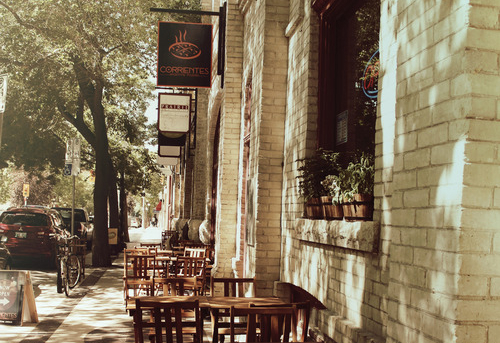There is an increasing acceptance of the fact that residential development is one of the most important things for downtown Winnipeg (the official push to make South of Portage a megaproject ghetto-cum-entertainment district notwithstanding). Moreover, it’s increasingly clear that lots of different kinds of people should be able to live downtown. Well-off residents and their spending power are seen as necessary, but so, too, are people of more moderate incomes.
These latter types are important, since they are more likely to enter and exit their buildings through the front door rather than through the underground parking entrance. They are the ones who are likely to walk around in the evenings, sit on the patios of local cafes and pubs, and do their shopping at whatever current and future grocery stores exist. Middle-income earners might not even care if their building has parking at all.
In other words, they’re the kinds of residents you’ll know are there.
The general thrust of Centre Venture’s latest plan, the $7.8-m Exchange-Waterfront Neighbourhood Development Program, seems to emphasize not just bringing more residents to the Exchange District, but to make it a nice place for them to walk around them. The most talked about aspect of the plan is the give $10,000 to anyone who purchases an unsold condo and promises to live in it for five years. It also includes streetscaping and safety measures, and some $110,000 to be spent on car-sharing programs, allowing residents access to a car for the occasions that they need it.
[related_content slugs=”small-zoning-reforms-could-make-a-big-difference,what-might-have-been-art-deco-at-portage-and-main,let-it-die-why-you-should-forget-about-the-albert,ten-best-places-to-get-a-beer-in-winnipeg,winnipeg-and-st-boniface-1962″ position=”right”]
While $10,000 might be a nice bonus for some price-conscious buyers, it remains an unwieldy attempt at bring about a very specific outcome. Namely, to correct the problem caused, in part, by the City heavily subsidizing the building of new condos through tax credits and other incentives over the past two years. This brought many new condos on the market (at a time when condo sales city-wide have slowed down) and many of them have not yet sold.
The $10,000 incentive may help clear the glut of unsold units in the Exchange, but what new set of distortions, inefficiencies will this add to the Exchange District residential market?
If anything, this incentive, and Centre Venture’s latest program overall–noble as its intentions may be–would only reinforce the status quo over the long term. Many developers would continue to stay risk-averse when it comes to the Exchange, and do little there without big handouts from government.
Opening access to the Exchange District market can happen by making the permit, zoning, and building code equivalency process more expedient. This creates greater predictability for developers and investors, and could help lower costs. It could also attract new developers who may not function on the same scale and profit margins that big, conventional companies do. Others, who have not yet attempted developments downtown, may also respond to a more open and predictable marketplace.
If incentives are necessary, let them be clear and consistent, and not just ad-hoc measures to correct the consequences of last year’s incentives.

While condo sales in the East Exchange have been slow, and the political nature of the development process erratic, it is important to remember that there is slow but steady progress in the neighbourhood. New residential units are being added through the construction of new buildings and the conversion of old ones. Many of these are selling. In some developments, unsold condos are are being rented out (which, in a rental-starved city, is a nice unintended consequence of all this).
This is a slow-growth town that is still deeply entrenched in suburban regulations, policy, and development patterns that need to change. While a few dozen condo units may not be selling as fast as some would like, there is no question that a neighbourhood is slowly emerging in the East Exchange District that practically did not exist 10 years ago. Let’s get out of the way and let it emerge.
___
Robert Galston likes to write about Winnipeg, urbanism, and other very, very exciting topics. Follow him on Twitter @riseandsprawl
For more, follow us on Twitter: @SpectatorTrib
